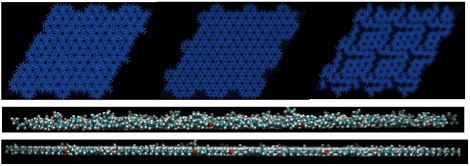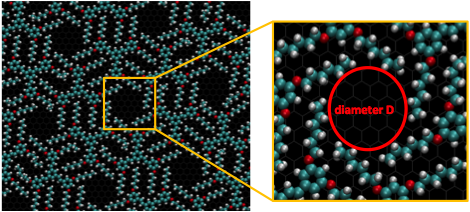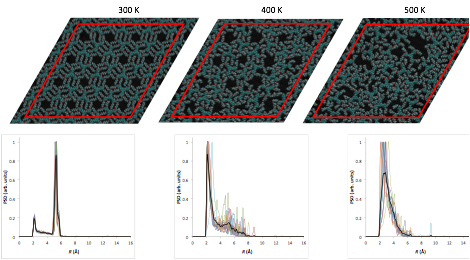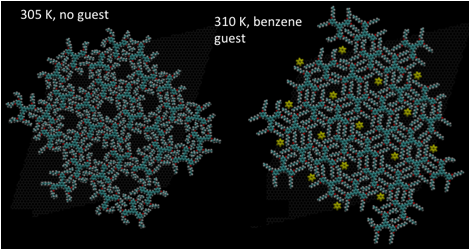Reports: ND552696-ND5: Two-Dimensional Nanoporous Self-Assembled Molecular Layers: New Structures for Selective Adsorption and Catalysis
Carlos Wexler, University of Missouri, Columbia
The emergence of nanoscience and the great successes in building nanotechnology have pushed the boundaries for exceptional control on the molecular and atomic scales. The ability to manipulate molecular degrees of freedom, for example, has led to the assembly of nanometer-scale materials such as carbon nanotubes [1], and zeolite-like porous materials [2]. Spontaneous molecular self-assembly is a promising route for bottom-up manufacturing of two-dimensional nanostructures with specific topologies [3,4,5,6]. Of particular interest is the possibility of selective lock-and-key interaction of guest molecules inside cavities, or pores, formed by complex self-assembled host structures. This type of surface nanostructure exhibits promising properties, such as selective adsorption and catalysis in solution. The self-assembly process is also an appealing route for bottom-up fabrication, being more efficient and cheaper than conventional top-down fabrication techniques, as the processes and mechanisms exploited are inherent to the molecular system [7]. The use of organic molecules in developing technology is also becoming an increasingly attractive route in fabrication and widespread use, for example, in organic photovoltaics and printable devices [8,9].
Our host structure is a monolayer consisting of interdigitated 1,3,5-tristyrylbenzene substituted by alkoxy peripheral chains containing n = 6, 8, 10, 12, or 14 carbon atoms (TSB3,5-Cn) deposited on a highly ordered pyrolytic graphite (HOPG) surface. The geometry of the TSB molecule, with its peripheral alkoxy chains, drives the self-assembly process through a lock-and-key mechanism, as it relaxes onto the HOPG substrate. Experimental studies have been carried out on a variety of molecules with triangular geometries, which tend to form honeycomb, or hexagonal, supramolecular networks through self-assembly [10,11,12].
Using ab initio methods from quantum chemistry, we optimize the molecular (geometric and electronic) structure of the TSB molecules, and calculate the parameters required for a force field specification. Beginning with the experimental results for the epitaxial relationship between the TSB35 overlayer and the HOPG substrate, which includes the lattice spacing parameter and domain angle, we then find the optimal lattice geometry. We then construct and analyze the structure and functionality for each of the TSB monolayers, and their ability to act as a molecular sieve through extensive molecular dynamics (MD) simulations. We observed a remarkable rigidity of the TSB superlattice, where variations of a few % in density result in either overcompressed systems (with severely distorted molecules—many gauche defects) or in emergence of large-scale rifts, Figure 1. We also observed sharp temperature-driven transitions between states with well-ordered pore structures and disordered states likely unsuitable for adsorption of guest molecules (Figures 2, 3). Finally, we observed the adsorption of guest molecules in the pores formed by the superlattice, and a curious effect by which these guest molecules stabilize the lattice and increase its “melting” transition temperature significantly (Figure 4).
Figure 1. Top left panel: verly compressed superlattice shows significant disorder (and a large number of gauche defects, center panel). Overly expanded superlattice (top right panel) shows a large-scale rift. Top right and bottom panels: ideal commensurate structure shows significant intra- and inter-molecular order at up to ~305K.
Figure 2. Determination of pore size distributions by fitting the largest possible circle with diameter D. See also Figure 3.
Figure 3. Top panels: melting of the superlattice with temperature. Bottom panels: pore size distributions show transitions between a well-ordered and stable pore structure with large pores to a highly chaotic set of pores, see Figure 2.
Figure 4. Stabilization of superlattice by presence of guest molecules.
REFERENCES
1. Majumder, M., Chopra, N., Andrews, R. & Hinds, B. J. Nanoscale hydrodynamics: enhanced flow in carbon nanotubes. Nature 438, 44 (2005).
2. FŽrey, G., Mellot-Draznieks, C., Serre, C., Millange, F., Dutour, J., SurblŽ, S. & Margiolaki, I. A Chromium Terephthalate-Based Solid with Unusually Large Pore Volumes and Surface Area. Science 309, 2040–2042 (2005).
3. Barth, J. V. Molecular architectonic on metal surfaces. Annu Rev Phys Chem 58, 375–407 (2007).
4. Theobald, J. A., Oxtoby, N.S., Philips, M.A., Champness, N.R. & Beton, P.H. Controlling molecular deposition and layer structure with supramolecular surface assemblies. Nature 424, 1029–1031 (2003).
5. Griessl, S. J. H., Lackinger, M., Jamitzky, F., Markert, T., Hietschold, M. & Heckl, W.M. Incorporation and Manipulation of Coronene in an Organic Template Structure. Langmuir 20, 9403–9407 (2004).
6. Stepanow, S., Lingenfelder, M., Dmitriev, A., Spillmann, H., Delvigne, E., Lin, N., Deng, X., Cai, C., Barth, J.V. & Kern, K. Steering molecular organization and host–guest interactions using two-dimensional nanoporous coordination systems. Nat Mater 3, 229–233 (2004).
7. Barth, J. V., Costantini, G. & Kern, K. Engineering atomic and molecular nanostructures at surfaces. Nature 437, 671–679 (2005).
8. Schmidt-Mende, L., Fechtenkštter, A., MŸller, K., Moons, E., Friend, R.H. & MacKenzie, J.D. Self-Organized Discotic Liquid Crystals for High-Efficiency Organic Photovoltaics. Science 293, 1119–1122 (2001).
9. Subramanian, V., Chang, P.C., Lee, J.B., Molesa, S.E. & Volkman, S.K. Printed organic transistors for ultra-low-cost RFID applications. IEEE Transactions on Components and Packaging Technologies 28, 742–747 (2005).
10. Balandina, T., Tahara, K., SŠndig, N., Blunt, M.O., Adisoejoso, J., Lei, S., Zerbetto, F., Tobe, Y., De Feyet, S. Role of Substrate in Directing the Self-Assembly of Multicomponent Supramolecular Networks at the Liquid-Solid Interface. ACS Nano 6, 8381-8389 (2012).
11. Szabelski, P., Rzysko, W., Panczyk, T., Ghijsens, E., Tahara, K., Tobe, Y., De Feyter, S. Self-assembly of molecular tripods in two dimensions: structure and thermodynamics from computer simulations. RSC Adv. 3, 25159-25165 (2013).
12. Ghijsens, E., Adisoejoso, J., Van Gorp, H., Destoop, I., Noguchi, A., Ivasenko, O., Tahara, K., Van der Auweraer, M., Tobe, Y., De Feyter, S. On the stability of surface-confined nanoporous molecular networks. J. Chem. Phys. 142, 101932 (2015).















